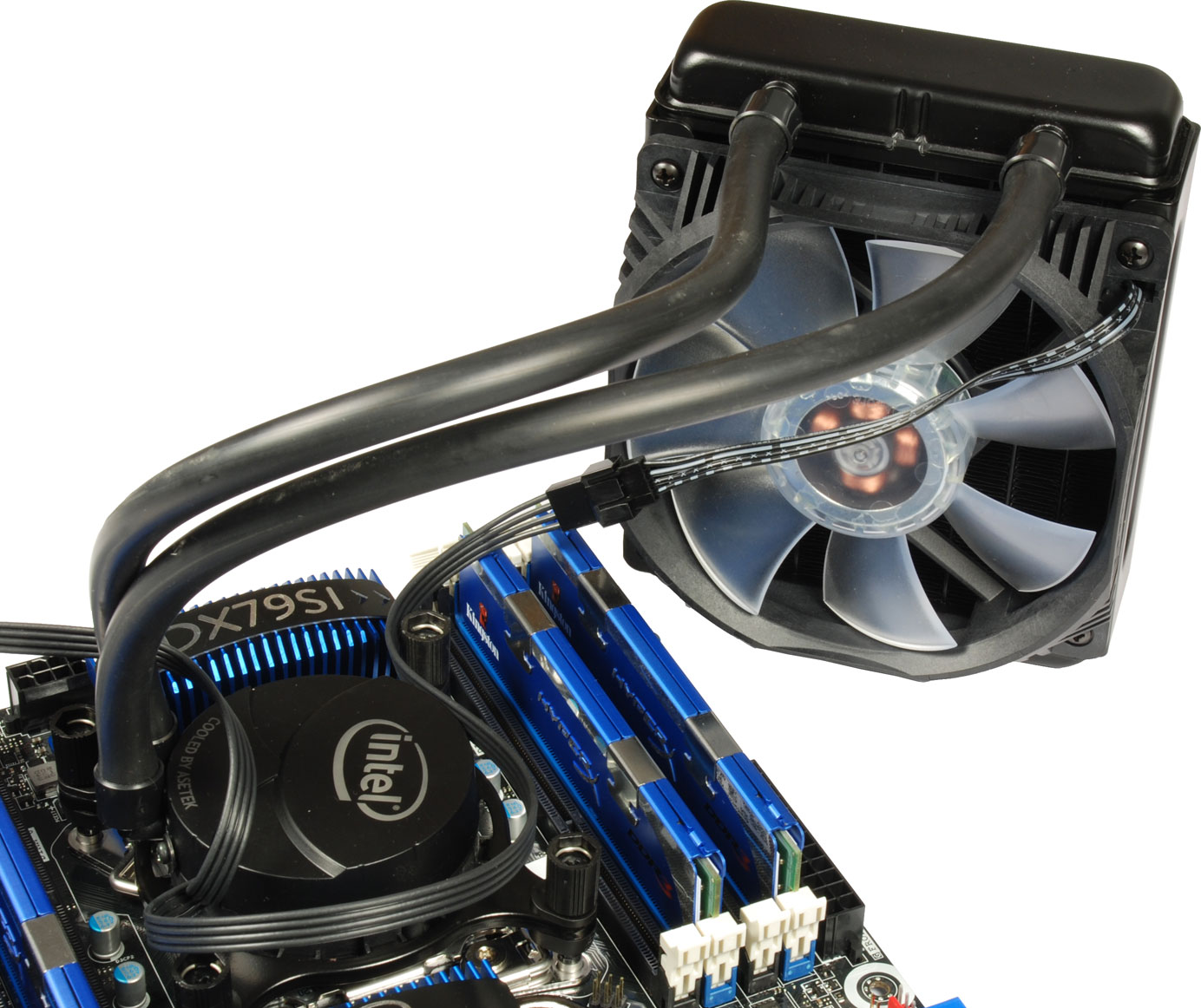Sandy Bridge-E: Core i7-3960X Is Fast, But Is It Any More Efficient?
Ironically, when it comes to performance, Intel’s Core i7-3960X is the real Bulldozer. Since its power consumption levels are lower than the Gulftown-based Core i7, it should also deliver amazing performance per watt as well. Is that really the case?
Hardware: Core i7-3960X, Intel DX79SI, Radeon HD 6850
The test sample Intel provided to our German crew is the same as the one that landed in the U.S.: the six-core Sandy Bridge-E chip branded as Core i7-3960X. It is specified to run at a base frequency up to 3.3 GHz with all six cores, but Turbo Boost 2.0 can take it up to 3.9 GHz when one or two cores are active.
In order to ensure maximum thermal headroom, we also received a closed-loop liquid cooling kit designed by Asetek and very similar to the products offered by Antec, Corsair, Cooler Master, and Cool IT. Interestingly, the solution provided here is not as large or as powerful as the one AMD delivered with its FX sample. We'll use the same liquid cooler when we analyze efficiency at overclocked settings in the very near future. Intel plans to make it available somewhere between $85-100, and it should fit all current Intel platforms.
There aren't many folks who'd spring for a $1000 CPU and the handicap it with insufficient cooling. So, we're using the closed-loop system for our efficiency exploration at stock clocks today. The result of ample cooling is better heat dissipation, which results in Turbo Boost holding its elevated clock rates for longer stretches without running into thermal bottlenecks.
Intel’s DX79SI is the company's highest-end motherboard, competing against products from ASRock, Asus, ECS, Evga, Gigabyte, and MSI, amongst others. If history is any indication, Intel's own retail platforms tend to be more conservative than the flagships from its third-party board partners. As such, they're generally not the first choice of hardcore enthusiasts. Now, that doesn't mean Intel's team isn't capable of designing a great motherboard; in fact, the DX79SI is perhaps its best effort to date. Notably, eight DIMM slots and three PCI Express slots represent inclusions that any power user is going to demand.
Thus, the DK79SI represents a good, stable platform for us to test on. It's not loaded with the number of features you'd expect to find on some of the more extravagant boards that Thomas is in the process of rounding up. However, it facilitates all of Sandy Bridge-E's performance, it enables its salient features, and it's stable.
The DX79SI comes armed with lots of USB 2.0 connectivity, a couple of USB 3.0 ports, gigabit Ethernet, and six SATA ports (two of which operate at data rates as high as 6 Gb/s), as well as software-based RAID support. The X79 Platform Controller Hub facilitates eight lanes of second-gen PCIe connectivity, while the processor contributes 40 lanes of PCI Express 3.0, which drive the board's three 16-lane slots.
Intel’s highest-end thermal solution is manufactured by Asetek, but it’s not a true high-end part as far as liquid cooling is concerned.
Get Tom's Hardware's best news and in-depth reviews, straight to your inbox.
Current page: Hardware: Core i7-3960X, Intel DX79SI, Radeon HD 6850
Prev Page Sandy Bridge-E: Could The -E Stand For Efficiency? Next Page Test Setup And Benchmarks
Patrick Schmid was the editor-in-chief for Tom's Hardware from 2005 to 2006. He wrote numerous articles on a wide range of hardware topics, including storage, CPUs, and system builds.
-
fstrthnu Aand yet more evidence that most people looking for a high-end processor will be perfectly fine with the i5-2500K or the 2600KReply -
sam_fisher fstrthnuAand yet more evidence that most people looking for a high-end processor will be perfectly fine with the i5-2500K or the 2600KReply
I guess it just depends on what you're doing. If you have a high end workstation and are using programs that are going to utilise all 12 threads, quad channel memory and 40 lanes of PCIe, and you need that processing power then it's probably not a bad investment. Whereas for most users the 2500K or the 2600K will do fine. -
benikens ReplyIronically, when it comes to performance, Intel’s Core i7-9360X is the real Bulldozer. Since its power consumption levels are lower than the Gulftown-based Core i7, it should also deliver amazing performance per watt as well. Is that really the case?
It's i7-3960x, not i7-9360x -
pwnorbpwnd Correct me if I'm wrong but isn't the 6850 a Barts card? Unless I am wrong but I own a 6850.Reply -
one-shot There is a small typo on Page 9Reply
"Total power used drops again relative to Cor ei7-3960X's predecessor, the Core i7-980X (Gulftown)." -
Shape ReplyIronically, when it comes to performance, Intel’s Core i7-9360X is the real Bulldozer.
ROFL!!! Very well said!
Nice! -
de5_Roy another informative, in-depth article about efficiency. great work guys!Reply
3960x might very well be the $1k cpu that's worth the (over)price unlike the older 980x.
sb-e shows that both single threaded and multi threaded performance as well as efficient power use can be ahcieved by a 32nm, 6 core, 130 tdp cpu (but you gotta pay a lot for that).
when you bring price into the equation, quad core sb i5 and i7(95w tdp) are the best way to go (i wonder how an i7 2700k fare if it was tested alongside these cpus). -
agnickolov And I was so hoping Visual C++ had made it into the regular benchmark set. Sadly, it's missing here...Reply -
giovanni86 Looking forward to seeing what type of Air/liquid cooled Overclocks can be achieved with these newly released processors.Reply



